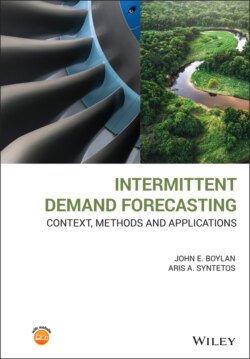Читать книгу Intermittent Demand Forecasting - John E. Boylan - Страница 79
3.5.2 Cycle Service Levels Based on All Cycles
ОглавлениеIn Chapter 2, we indicated why the distribution of demand over the whole protection interval () is needed to determine OUT levels in periodic review systems. To recap, suppose that the stock on hand is at the OUT level just after a review and no order is triggered. In that case, the stock must last not just until the time of the next review (an interval of R time units), but until any stock is received after that review. This necessitates a further delay of L time units, to allow for the supplier's lead time. Care is needed in counting the length of the lead time. The use of an protection interval assumes that an order placed at the end of period arrives in time to satisfy demands of period . If it arrives in time to satisfy the demands of period , then the effective lead time is and, for review intervals of length one period, the protection interval is of length rather than (Teunter and Duncan 2009).
Suppose that the demand distribution in Table 3.2 accurately represents the probabilities of future demand values over a single week, and that demand is independent and identically distributed. We are using a periodic review system, with a review interval of one week and a lead time of one week. Therefore, the protection interval is two weeks, and the distribution of demand over two weeks is shown in Table 3.3.
Table 3.3 Probability distribution of total demand over two weeks.
| Total | Week 1 | Week 2 | Week 1 | Week 2 | Product | Total |
|---|---|---|---|---|---|---|
| 0 | 0 | 0 | 0.5 | 0.5 | 0.25 | 0.25 |
| 1 | 1 | 0 | 0.3 | 0.5 | 0.15 | |
| 0 | 1 | 0.5 | 0.3 | 0.15 | 0.30 | |
| 2 | 2 | 0 | 0.2 | 0.5 | 0.10 | |
| 1 | 1 | 0.3 | 0.3 | 0.09 | ||
| 0 | 2 | 0.5 | 0.2 | 0.10 | 0.29 | |
| 3 | 2 | 1 | 0.2 | 0.3 | 0.06 | |
| 1 | 2 | 0.3 | 0.2 | 0.06 | 0.12 | |
| 4 | 2 | 2 | 0.2 | 0.2 | 0.04 | 0.04 |
Table 3.4 Cumulative distribution of total demand over two weeks.
| Demand | Probability | Cumulative probability |
|---|---|---|
| 0 | 0.25 | 0.25 |
| 1 | 0.30 | 0.55 |
| 2 | 0.29 | 0.84 |
| 3 | 0.12 | 0.96 |
| 4 | 0.04 | 1.00 |
In Table 3.3, denotes demand over the review interval (Week 1), demand over the lead time (Week 2), and demand over the protection interval (Weeks 1 and 2). Probability is denoted by the symbol .
To find the probabilities in Table 3.3, we first consider all the possible ways of achieving the demand values over two weeks. For example, a total demand of two can be achieved in three ways (two in Week 1, zero in Week 2; or one in Week 1, one in Week 2; or zero in Week 1 and two in Week 2). The full listings are given in the second and third columns of Table 3.3.
The probabilities in the fourth and fifth columns are taken directly from Table 3.2. The product of these probabilities in the sixth column represents the chance of a particular sequence of demands in Weeks 1 and 2 (assuming independence of demands). In the final column, the probabilities are summed appropriately, for each potential value of total demand over two weeks. For example, the probability of having a total demand of two is the sum of 0.10, 0.09, and 0.10, giving a value of 0.29. Now that the probabilities of demand over two weeks have been calculated, we can find the cumulative probability distribution, which represents the probabilities of observing particular demand values, or less than those values, as shown in Table 3.4.
The cumulative distribution of total demand over the protection interval is often used as an approximation to the cycle service level in inventory systems (Cardós and Babiloni 2011). (The reasons why this is approximate, rather than exact, will be explained in Section 3.5.3.) Therefore, the approximate service levels may be read directly from the cumulative probabilities in Table 3.4, which shows a CSL of 84% if the OUT level is set at two units and a CSL of 96% if the OUT level is set at three units. So, knowledge of all the probabilities of demand (the demand distribution) is sufficient to allow the calculation of the approximate CSL for different OUT levels if demand is independent and identically distributed.
